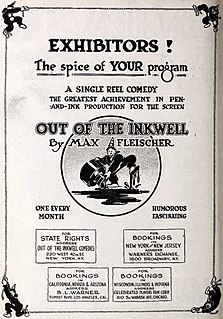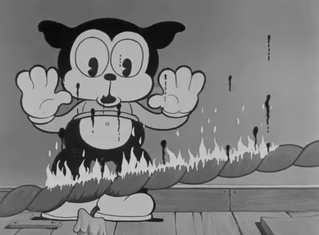Related Research Articles

Snow-White is a 1933 American animated short in the Betty Boop series from Max Fleischer's Fleischer Studios. Dave Fleischer was credited as director, although virtually all the animation was done by Roland Crandall, who received the opportunity to make Snow-White on his own as a reward for his several years of devotion to the Fleischer studio. The resulting film, which took six months to complete, is considered both Crandall's masterwork and an important milestone of the Golden age of American animation.

Fleischer Studios is an American animation studio founded in 1929 by brothers Max and Dave Fleischer, who ran the pioneering company from its inception until its acquisition by Paramount Pictures, the parent company and the distributor of its films. In its prime, Fleischer Studios was a premier producer of animated cartoons for theaters, with Walt Disney Productions being its chief competitor in the 1930s. Today, the company is again family owned and oversees the licensing and merchandising for its characters.

Max Fleischer was an American animator, inventor, film director and producer, and studio founder and owner. Born in Kraków, Fleischer immigrated to the United States where he became a pioneer in the development of the animated cartoon and served as the head of Fleischer Studios, which he co-founded with his younger brother Dave. He brought such comic characters as Koko the Clown, Betty Boop, Popeye, and Superman to the movie screen, and was responsible for several technological innovations, including the rotoscope, the "follow the bouncing ball" technique pioneered in the Ko-Ko Song Car-Tunes films, and the "stereoptical process". Film director Richard Fleischer was his son.

Betty Boop is an animated cartoon character created by Max Fleischer, with help from animators including Grim Natwick. She originally appeared in the Talkartoon and Betty Boop film series, which were produced by Fleischer Studios and released by Paramount Pictures. She was featured in 90 theatrical cartoons between 1930 and 1939. She has also been featured in comic strips and mass merchandising.
Talkartoons is a series of 42 animated cartoons produced by Fleischer Studios and distributed by Paramount Pictures between 1929 and 1932.

Koko the Clown is an animated character created by Max Fleischer. He first appeared as the main protagonist in Out of the Inkwell (1918-1929), a major animated series of the silent era. Throughout the series, he goes on many adventures with his canine companion “Fitz the Dog”, who would later evolve into Bimbo in the Betty Boop cartoons.
Animated films in the United States date back to at least 1906 when Vitagraph released Humorous Phases of Funny Faces. Although early animations were rudimentary, they rapidly became more sophisticated with such classics as Gertie the Dinosaur in 1914, Felix the Cat, and Koko the Clown.

Out of the Inkwell is an American major animated series of the silent era produced by Max Fleischer from 1918 to 1929.

Bimbo is a tubby, black and white cartoon pup created by Fleischer Studios. He is most well known for his role in the Betty Boop cartoon series, where he featured as Betty's main love interest. A precursor design of Bimbo, originally named Fitz, first appeared in the Out of the Inkwell series.

Dave Fleischer was an American film director and producer, best known as a co-owner of Fleischer Studios with his older brother Max Fleischer. He was a native of New York City.
HaroldSeeger was an American animated cartoon producer and director who owned his own studio the Hal Seeger Studio. He is most famous as the creator of the 1960s animated series Batfink, Milton the Monster and Fearless Fly. During the 1930s and 1940s he was also active as a comics writer and artist, most famously for the Betty Boop comic strip and Leave It to Binky.
Bernard "Berny" Wolf was an American animator and television producer.
Swim Or Sink is a 1932 Fleischer Studios animated short film directed by Dave Fleischer and starring Betty Boop, Koko the Clown, and Bimbo. It was reissued under the titles S.O.S.
Out of the Inkwell is a 1938 Max Fleischer/Betty Boop live-action and animated short film. The title and concept for the film were a tribute to the Out of the Inkwell series of films that Max Fleischer had produced during the 1920s.
Betty Boop's Rise to Fame is a 1934 Fleischer Studios animated short film, starring Betty Boop.
Betty Boop, M.D. is a 1932 Fleischer Studios animated short film starring Betty Boop, and featuring Koko the Clown and Bimbo. The animated short is certainly one of the more surreal entries in the Betty Boop filmography.
Betty Boop's Museum is a 1932 Fleischer Studios animated short film starring Betty Boop, and featuring Koko the Clown and Bimbo.
Betty Boop's Ker-Choo is a 1933 Fleischer Studios animated short film starring Betty Boop, and featuring Koko the Clown and Bimbo.

Betty Boop's Birthday Party is a 1933 Fleischer Studio animated short film, starring Betty Boop and featuring Koko the Clown and Bimbo.
Boop-Oop-a-Doop is an animated short film created by Fleischer Studios on January 16, 1932, as part of the Talkartoon series.
References
- ↑ Lenburg, Jeff (1999). The Encyclopedia of Animated Cartoons. Checkmark Books. pp. 54–56. ISBN 0-8160-3831-7 . Retrieved 6 June 2020.